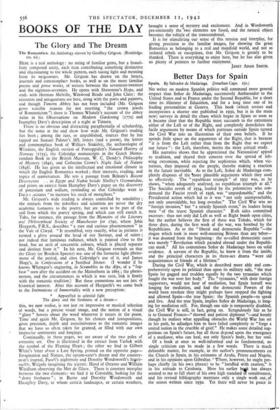BOOKS OF THE DAY
The Glory and The Dream
HERE is a real anthology : no string of familiar gems but a beauti- fully composed unity, each item contributing something distinctive and illuminating to the whole pattern, each taking light and meaning from its neignoours. Mr. Grigson has drawn on the letters, journals and commonplace books, as yvell as on the more familiar poems and prose works, of writers between the seventeen-twenties and the eighteen-seventies. He opens with Shenstone's Hope, and ends with Herman Melville, Winwood Reade and John Clare: the scientists and antiquarians are here, along with the poets and painters, and though Tintern Abbey has not been included (Mr. Grigson gives sensible reasons for not resetting "the crown jewels of Romanticism ") there is Thomas Whately's account of the abbey ruins in his Observations on Modern Gardening (I770) and humphry Davy's description of a night at Tintern.
There is no obvious and distracting paraphernalia of scholarship, but the notes at the end show how wide Mr. Grigson's reading has been ; among the rare, or unpublished, shurces that he has tapped are Samuel Palmer's MS. letters (and a poem), the letters and commonplace book of William Stukeley, the archaeologist of Wiltshire, the English version of Pontoppidan's Natural History of Norway (1755), the Coleridge manuscripts in the Gutch Memo- randum Book in the British Museum, W. C. Dendy's Philosophy of Mystery (184?), and Catherine C.rowe's Night Side of Nature (1848). He has given us the intellectual and emotional climate in which the English Romantics worked ; their interests, reading, and topics of conversation. He sets a passage from Belzoni's Recent Discoveries . . in Egypt and Nubia beside Shelley's Ozymandias, and prints an extract from Humphry Davy's paper on the discovery of potassium and sodium, reminding us that Coleridge went to Davy s Jectures "to increase his stock of metaphors."
Mr. Grigson's wide reading is always controlled by sensibility ; the extracts from the travellers and scientists are never the dry academic footnotes to the poetry, but are seen to be part of the soil from which the poetry sprang, and which can still enrich it. Take, for instance, the passage from the Memoirs of the Literary and Philosophical Society of Manchester for 1790, where John Haygarth, F.R.S., describes "a rare and curious phaenomenon " in the Vale of Clwyd. "It resembled, very exactly, what in pictures is termed a glory around the head of our Saviour, and of saints ; not indeed that luminous radiance, which is painted close to the head, but an arch of concentric colours, which is placed separate and distinct from it." In his note, Mr. Grigson reminds us that the Glory (or Brocken Spectre) ww. one of the favourite light pheno- mena of the period, and cites Coleridge's use of it, and James Hogg's, in Confessions of a 7ustified Sinner. (I wonder if he knows Whymper's engraving, in Scrambles in the Alps, of a " fog- bow " seen after the accident on the Matterhorn in 1865 • the pheno- menon, and the circumstances in which it was seen, link it firmly with the romantic tradition.) But these connexions are not just of historical interest. After this account of Haygarth's we come back to the Intimations of Immortality with a new perception: • Apparelled in celestial light The glory and the freshness of a dream—
this, we now realise, is not just an impressive or musical selection of words, but a precise visual image, and the notion of a visual " glory " hovers about the word whenever it recurs in the poem. Time and again Mr. Grigson, by his choices and juxtapositions, gives precision, depth and associativeness to the romantic images that we have so often taken for granted, or filled with our own imprecise sentiments and longings. Continually, in these pages, we are aware of the two poles of romantic art. One is illustrated in the extract from Vathek with the symbol of the Flaming Heart ; the other we find in Gilbert White's !etter at-out a Late Spring, printed on the opposite page— Imagination and Nature, the opium-eater's dream and the country- man's journal, Fuselfs nightmare and Dorothy Wordsworth's hopey- suckle, Walpole imagining the giganti:.: Hand of Otranto and William Windham observing the Mer de Glace. There is constant interplay between the two elements : we find it in Constable looking for the "dewy freshness " ; in Burns and Dorothy Wordsworth and Humphry Davy, to whom certain landscapes, or certain weathers, brought a sense of mystery and excitement. And in Wordsworth pre-eminently the two elements are fused, and the natural object becomes the vehicle of the transcendental. '
It is for stimulating our sense of this tension and interplay, for giving precision to the familiar images for showing the great Romantics as belonging to a real and manifold world, and not as isolated rebels or exceptions, that Mr. Grigson is greatly to be thanked. There is everything to enjoy here, but he has also given us plenty of pointers to further enjoyment.
JANET ADAM SMITH.


























 Previous page
Previous page